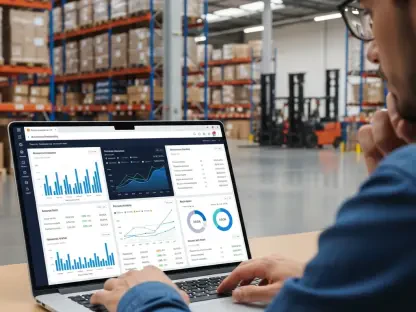Setting the Stage: The Data-Driven Supply Chain Imperative
In today’s fast-paced global economy, supply chain management faces unprecedented pressure to adapt, with inefficiencies costing businesses billions annually. A staggering reality emerges from recent industry studies: nearly 70% of supply chain disruptions stem from inaccurate or inaccessible data, stunting the potential of even the most advanced technologies. This analysis dives deep into why cleaner data is becoming the cornerstone of a transformative revolution in supply chain operations. It examines current market trends, dissects the role of data integrity in driving technological adoption, and projects how these shifts will redefine efficiency and competitiveness. The focus is clear—understanding and leveraging reliable data is no longer a choice but a critical necessity for companies aiming to thrive in an increasingly complex landscape.
Market Trends: Data as the Backbone of Supply Chain Evolution
Historical Context and Current Challenges
Supply chains have evolved dramatically over recent decades, transitioning from localized networks to intricate global systems. This complexity, while enabling scale, has exposed vulnerabilities, particularly during disruptions like geopolitical conflicts or natural disasters. A persistent issue dominating market discussions is the historical reliance on fragmented data systems—early tools like enterprise resource planning often failed to deliver promised efficiencies due to inconsistent inputs. Today, as digital transformation accelerates, the market reveals a critical gap: without clean, standardized data, investments in cutting-edge solutions risk falling flat. Industry reports highlight that companies prioritizing data hygiene are already seeing up to 20% improvements in operational accuracy, underscoring a trend toward foundational readiness as a prerequisite for innovation.
The Rise of Purpose-Driven Technology Adoption
A notable shift in the market is the move away from adopting technology for novelty toward aligning it with specific business needs. Companies are increasingly focusing on pinpointing friction points—such as delayed reporting or mismatched inventory records—before deploying solutions like artificial intelligence (AI). This strategic pivot reflects a broader recognition that technology must serve clear objectives, whether enhancing agility or meeting sustainability targets. Market analysis indicates that firms starting with simpler fixes, like unifying data formats across platforms, often achieve quicker returns compared to those chasing complex tools prematurely. This trend suggests a maturing market where practicality trumps hype, setting the stage for more sustainable growth.
AI’s Transformative Impact on Operational Models
Artificial intelligence is reshaping supply chain workflows, moving operations from rigid, manual processes to adaptive systems with autonomous decision-making capabilities. Market data shows that AI-driven tools, such as predictive analytics for demand forecasting, can reduce inventory costs by up to 30% when supported by reliable data. However, a significant barrier persists—lack of trust among employees often leads to resistance or manual overrides, stalling progress. Successful players in the market are those investing in cultural integration, ensuring teams understand and embrace data-driven outputs. This human-tech synergy is emerging as a defining factor, with early adopters gaining a competitive edge through smoother implementation and higher efficiency.
Projections: Leaner and Smarter Supply Chains Ahead
Redefining Efficiency with Compact Operations
Looking forward, market projections point to a future where cleaner data enables significantly leaner supply chain structures. AI capabilities like predictive maintenance and optimized inventory placement are expected to minimize the need for expansive physical infrastructure, reducing warehouse footprints and enhancing equipment uptime. Industry forecasts suggest that by 2027, firms leveraging such data-driven strategies could cut operational costs by 15-25%, particularly in sectors like manufacturing and retail. This concept of a “smaller supply chain” is gaining traction, with regional variations—North American markets prioritize cost reduction, while European counterparts align with stringent environmental regulations. The potential for downsizing physical operations represents a transformative opportunity for forward-thinking businesses.
Emerging Technologies and Regulatory Pressures
Technological advancements are set to further refine data accuracy and transparency in supply chains over the coming years. Innovations like real-time analytics and blockchain are projected to enhance trust and traceability, addressing long-standing issues of data silos. Simultaneously, regulatory pressures, especially around sustainability, are pushing companies to leverage cleaner data for greener practices—market estimates indicate that compliance costs could rise by 10% annually for non-adopters. The interplay of tech and regulation is creating a dynamic landscape where data integrity becomes a dual driver of efficiency and accountability. Companies ignoring these converging forces risk falling behind as the market evolves toward hyper-connected, sustainable ecosystems.
The Evolving Role of Supply Chain Leadership
Another critical projection centers on the changing role of supply chain leadership, particularly the Chief Supply Chain Officer (CSCO). No longer confined to cost management, CSCOs are increasingly positioned as growth catalysts, bridging connections across sales, marketing, and technology domains. Market insights predict that by 2027, over 60% of CSCOs will oversee integrated digital strategies, relying heavily on clean data to drive decision-making. This shift underscores a broader trend toward interdisciplinary expertise, with aspiring leaders encouraged to build skills in data analytics and operational experience. The market is clearly moving toward a future where supply chain roles are pivotal to overall business strategy, amplifying the importance of data readiness.
Reflecting on the Path Forward: Strategic Insights
Looking back on this analysis, it is evident that cleaner data has emerged as the linchpin of supply chain transformation, with market trends and projections painting a compelling picture of opportunity and challenge. The journey through historical challenges, current adoption patterns, and future efficiencies highlights a unified insight: technology’s promise is only realized when built on a foundation of reliable information. For businesses that have navigated this terrain, the implications are profound—those who have prioritized data integrity gain a measurable edge in operational performance and market positioning. The key takeaway is the need to act decisively, focusing on internal readiness to unlock sustainable innovation.
Beyond reflection, actionable steps emerge as vital for companies aiming to stay competitive. Starting with comprehensive data audits to eliminate inconsistencies proves essential, as does investing in employee training to foster trust in new systems. Exploring leaner operational models, supported by precise data, offers a pathway to cut costs while aligning with regulatory demands. For industry leaders, the focus shifts to cultivating a blend of technical and strategic acumen, ensuring adaptability in an interconnected future. These strategies, grounded in the lessons of this analysis, provide a roadmap for turning data into a powerful driver of supply chain success.









